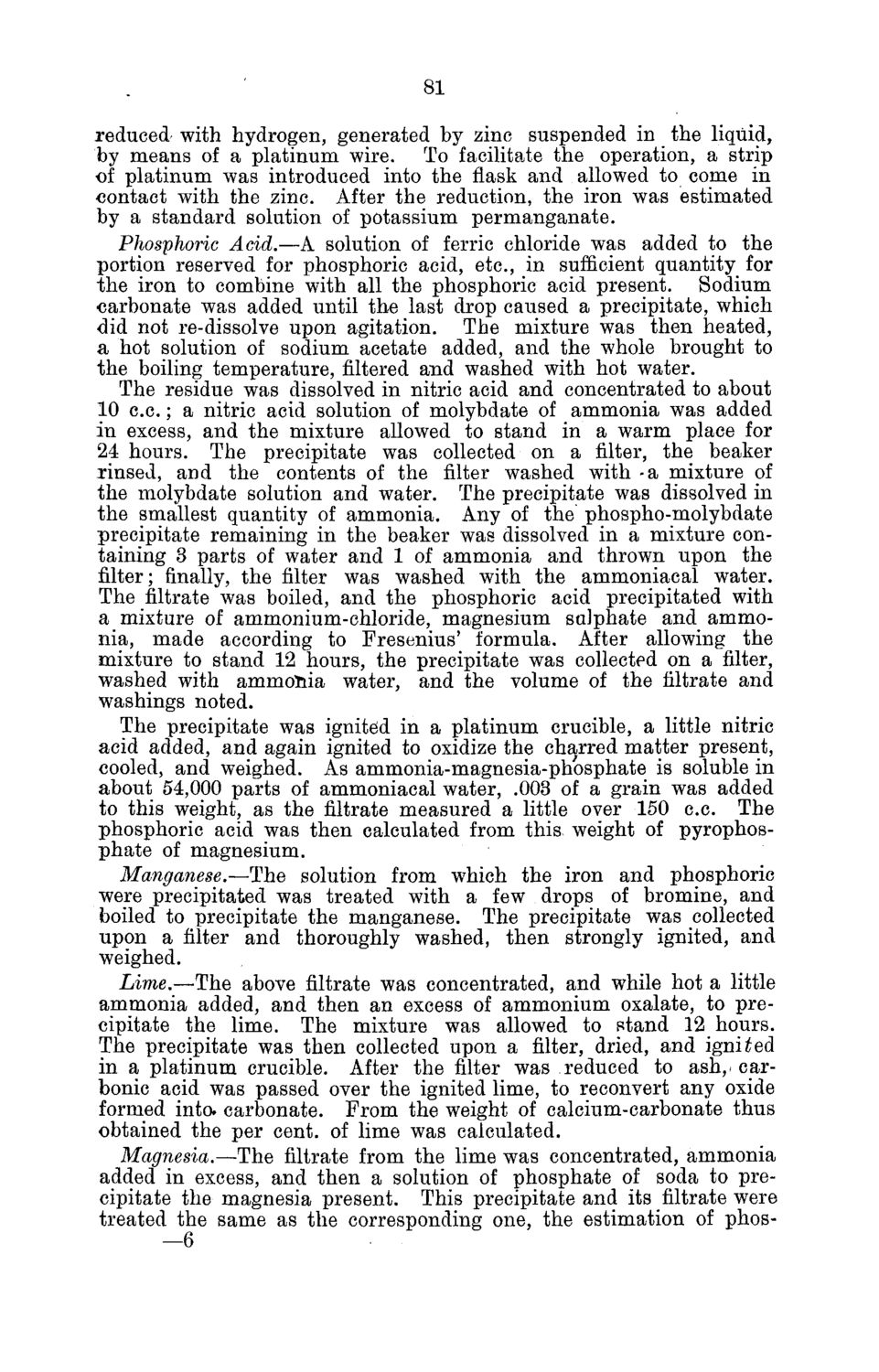| |
| |
Caption: Board of Trustees Minutes - 1882
This is a reduced-resolution page image for fast online browsing.

EXTRACTED TEXT FROM PAGE:
81 reduced with hydrogen, generated by zinc suspended in the liquid, by means of a platinum wire. To facilitate the operation, a strip of platinum was introduced into the flask and allowed to come in contact with the zinc. After the reduction, the iron was estimated by a standard solution of potassium permanganate. Phosphoric Acid.—A solution of ferric chloride was added to the portion reserved for phosphoric acid, etc., in sufficient quantity for the iron to combine with all the phosphoric acid present. Sodium carbonate was added until the last drop caused a precipitate, which did not re-dissolve upon agitation. The mixture was then heated, a hot solution of sodium acetate added, and the whole brought to the boiling temperature, filtered and washed with hot water. The residue was dissolved in nitric acid and concentrated to about 10 c.c.; a nitric acid solution of molybdate of ammonia was added in excess, and the mixture allowed to stand in a warm place for 24 hours. The precipitate was collected on a filter, the beaker rinsed, and the contents of the filter washed with -a mixture of the molybdate solution and water. The precipitate was dissolved in the smallest quantity of ammonia. Any of the phospho-molybdate precipitate remaining in the beaker was dissolved in a mixture containing 3 parts of water and 1 of ammonia and thrown upon the filter; finally, the filter was washed with the ammoniacal water. The filtrate was boiled, and the phosphoric acid precipitated with a mixture of ammonium-chloride, magnesium sulphate and ammonia, made according to Fresenius' formula. After allowing the mixture to stand 12 hours, the precipitate was collected on a filter, washed with ammoTiia water, and the volume of the filtrate and washings noted. The precipitate was igniteid in a platinum crucible, a little nitric acid added, and again ignited to oxidize the charred matter present, cooled, and weighed. As ammonia-magnesia-phosphate is soluble in about 54,000 parts of ammoniacal water, .003 of a grain was added to this weight, as the filtrate measured a little over 150 c.c. The phosphoric acid was then calculated from this weight of pyrophosphate of magnesium. Manganese.—The solution from which the iron and phosphoric were precipitated was treated with a few drops of bromine, and boiled to precipitate the manganese. The precipitate was collected upon a filter and thoroughly washed, then strongly ignited, and weighed. Lime.—The above filtrate was concentrated, and while hot a little ammonia added, and then an excess of ammonium oxalate, to precipitate the lime. The mixture was allowed to stand 12 hours. The precipitate was then collected upon a filter, dried, and ignited in a platinum crucible. After the filter was reduced to ashy carbonic acid was passed over the ignited lime, to reconvert any oxide formed into, carbonate. Prom the weight of calcium-carbonate thus obtained the per cent, of lime was calculated. Magnesia.—The filtrate from the lime was concentrated, ammonia added in excess, and then a solution of phosphate of soda to precipitate the magnesia present. This precipitate and its filtrate were treated the same as the corresponding one, the estimation of phos—6
| |